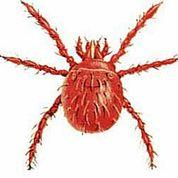Harvest mites are mites that are commonly found in forests and grasslands. They can also be known as red bugs, berry bugs or in their larval stage as chiggers. Harvest mites are relatives of spiders. They are nearly microscopic and have an orange hue. They most frequently infect humans and animals in their larval stage in autumn, hence the name harvest mites.

What a Harvest Mite looks like under microscopic examination.
The larval stage is the only stage that feeds on warm blooded animals. All other stages of the Harvest mite live in the environment and are not parasitic. They often live in berry patches, tall grass and weeds, woody areas, leaves and bark or mulch. The larvae are active during the day, in dry, sunny weather. When they come in contact with animals, they swarm onto it and attach onto the skin, especially in thinly haired areas of skin. They then feed for two to three days and then drop off onto the ground to complete their life cycle. The larval mite is orange and barely visible to the naked eye.
What do harvest mites do to animals?
The Harvest mite larvae do not burrow deep into the skin. They live on the surface. During feeding, they pierce the skin and inject powerful enzymes that digest skin cells so they can be consumed by the larvae. These enzymes are irritating and result in intense itching causing the animal to chew or scratch at itself, resulting in self-inflicted wounds. The resulting lesions vary from crusted spots to areas of hair loss to raw moist bleeding areas.

Harvest mite larvae seen on a patient at City Vet.
In pets, Harvest mites are most commonly found around the ears and between the toes but can be found almost anywhere on the body. Individual pets vary greatly in their sensitivity to the bite of the mites. Cats that are frequently bitten may develop allergies to the mites resulting in severe clinical signs.
Diagnosis of Harvest mites
A sudden onset of intense itching during the late summer or early autumn suggests that Harvest mites or a similar ectoparasite such as fleas may be present. Many cats will ingest the biting larvae while grooming and the orange insects may not be seen. A veterinary practitioner will make a diagnosis by identifying the mite. Accumulations of mites may be seen as intensely orange spots on the skin. If fewer mites are present, they may be seen on microscopic examination of a superficial skin scraping.
Treatment of Harvest mites
There are currently no products licenced for the treatment of Harvest mites in cats and dogs. Many insecticides approved for flea control will effectively kill Harvest mites, if they are correctly applied. It is important to use a product with good residual activity and to confine animals indoors during Harvest mite season. In most cases, pets will not need any further treatment once the mites have been killed. In cats that are sensitive to bites from Harvest mite larvae, additional treatment with anti-inflammatory medications may be indicated. In cases with secondary skin infections, antibiotics may be needed also.
Do Harvest mites affect humans?
People can be affected by Harvest mites but they are not spread from cats or dogs. They are picked up from infested outdoor environments and they will typically attach to people’s ankles. The typical skin reactions consists of an intensely irritating rash. Specific treatment is usually unnecessary.
Based on material written by Ernest Ward, DVM.